Jan 06, 2026
Jan 06, 2026
The Marvels of Far East (Ancient China)
Continued from Previous Page
There is no unanimity among the historians and scholars about any single most ancient civilization being the cradle of civilization in the world as, ordinarily, this term shall be used for the for the geographical entity where the human civilization is believed to have independently evolved at some point of time. However, the general consensus appears to be among the Western scholars that the Mesopotamia, Ancient India, Egypt and China were the earliest civilizations in the Old World. We are aware of the constant eastward expeditions undertaken by the Greeks, Romans and Persian conquerors right from Persian Cyrus and Greek Alexander since 1st millennium BCE (also identified as last millennium BCE) up to the Indian sub-continent which, besides adverse fall outs, also allowed the knowledge and fusion of different cultures. However, the mighty Himalayas and its allied Mountain ranges always served as a natural barrier as also a strong defence for the Far East; hence its civilization remained immune to external influence but, at the same time, very little remained known about the Chinese civilization to the rest of the world for a very long time.
Although officially Marco Polo, a merchant and explorer from Venice, Italy is accredited with exploring and establishing a formal contact with China during the thirteenth century CE, there are some archaeological and other evidences to establish that China and Western Old World were in contact for at least 1,500 years before the aforesaid European explorer. Then China land was referred to as ‘Cathay’, and in Mandarin the country was known as something meaning as the "Central State" or "Middle Empire". It appears that the access from the West to the Far East was through the ‘Silk Route’ which is believed to be in existence from 2nd century BCE to the 18th century CE for economic, cultural and religious interaction.
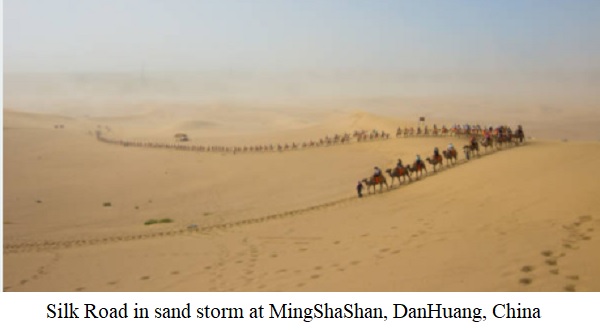
The name as such was derived from the lucrative silk trade which is believed to have begun in 207 BCE during the Han dynasty in China and then Greeks and Roman knew the country as Seres i.e the land of silk and there was a time when Romans considered silk as precious and costlier than gold. The name China apparently first appeared in Portuguese traveler Duarte Barbosa’s “Book of Duarte Barbosa” in 1516 CE describing his ventures in the east.
A Brief Civilizational History of China
At least two fossil records, one a tooth from Peking Man recorded in 1927 at Zhoukoudian near Beijing and two upper incisors, a partial tibia and other remains presumed to have belonged to Yuanmou Men found in Yuanmou in 1965, suggest that the region was inhabited by hominids since prehistoric times and the early inhabitants were skilled in stone tools and use of fire. Thus, it appears the history of human evolution in China is very old and independent of Western civilizations. It is generally believed that the Yellow River (Huang he) Valley is the cradle of Chinese civilization that gave rise to early villages around 5000 BCE. There are divergent views about the spread of population, but it is generally believed that the Henan province was the site of several villages and farming communities at the beginning. This rather less organized farming and community living was prevalent for almost three millennia before these small villages and farming communities grew into the first centralized governance with the formation of the Xia dynasty (2070-1600 BCE).
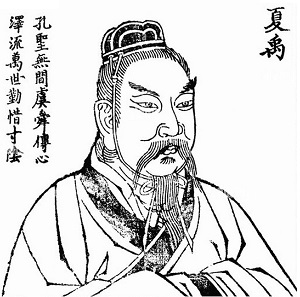 The Xia dynasty was established by a legendary Da Yu (also Yu the Great) who is believed to have worked assiduously for over a decade to control flooding of the Yellow River which used to destroy crops in almost cyclic manner every year. This dynasty has been considered mythical for a long time by historians until after scientific excavations revealed many remnants of Bronze works, tombs, and so on at Erlitou, Henan in 1959 suggesting the occurrence of a recognizable cohesive civilization in the past. Yu is believed to have established a hereditary system by nominating his successor thereby introducing the concept of dynasty. While the elite class largely inhabited the urban clusters, peasant class remained in agrarian set up in rural areas. Yu’s son Qi became ruler after the former’s death and the same heredity line continued until Jie, the last in the dynastic succession, was overthrown by Tang who established the Shang Dynasty that lasted for over five centuries.
The Xia dynasty was established by a legendary Da Yu (also Yu the Great) who is believed to have worked assiduously for over a decade to control flooding of the Yellow River which used to destroy crops in almost cyclic manner every year. This dynasty has been considered mythical for a long time by historians until after scientific excavations revealed many remnants of Bronze works, tombs, and so on at Erlitou, Henan in 1959 suggesting the occurrence of a recognizable cohesive civilization in the past. Yu is believed to have established a hereditary system by nominating his successor thereby introducing the concept of dynasty. While the elite class largely inhabited the urban clusters, peasant class remained in agrarian set up in rural areas. Yu’s son Qi became ruler after the former’s death and the same heredity line continued until Jie, the last in the dynastic succession, was overthrown by Tang who established the Shang Dynasty that lasted for over five centuries.
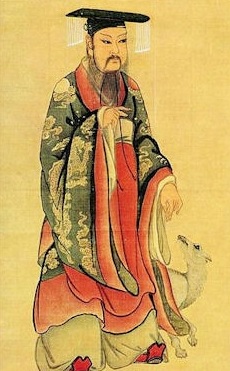 The Shang Dynasty (1600-1046 BCE) lasted for over five centuries. Not much is known about the antecedents of Tang but it is believed that the Xia dynasty misrule had overburdened the populace and Tang assumed the leadership of the popular uprisings against the then ruler Jie. In the consequent revolt, Tang led the forces against Jie and defeated him at the battle of Mintiao around 1600 BCE. During the Shang Dynasty, bronze metallurgy, architecture, art of writing and religiosity had developed and well prospered. During this time, people worshipped multiple deities and the head of pantheon was god Shangdi. People believed in spirits and sophisticated rituals were followed to appease the spirits of ancestors which were buried in tombs to ensure their comfortable afterlife. Hereditary rule evolved during the Xia Dynasty was followed and the Shang kings, in addition to their mundane duties, also functioned as the chief officiate and mediator between the living world and dead ancestors.
The Shang Dynasty (1600-1046 BCE) lasted for over five centuries. Not much is known about the antecedents of Tang but it is believed that the Xia dynasty misrule had overburdened the populace and Tang assumed the leadership of the popular uprisings against the then ruler Jie. In the consequent revolt, Tang led the forces against Jie and defeated him at the battle of Mintiao around 1600 BCE. During the Shang Dynasty, bronze metallurgy, architecture, art of writing and religiosity had developed and well prospered. During this time, people worshipped multiple deities and the head of pantheon was god Shangdi. People believed in spirits and sophisticated rituals were followed to appease the spirits of ancestors which were buried in tombs to ensure their comfortable afterlife. Hereditary rule evolved during the Xia Dynasty was followed and the Shang kings, in addition to their mundane duties, also functioned as the chief officiate and mediator between the living world and dead ancestors.
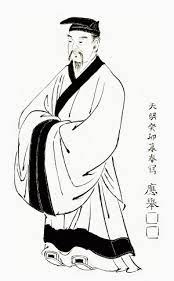 In the Chinese history, the Zhou Dynasty (1046 – 256 BC) had the longest stint among the early dynasties. The Zhou had initially evolved as a semi-feudal system in west of the Shang Dynasty and their leader was accredited as the western protector of the Shang. Later, around 1046 BCE, the King Wu of Zhou with the assistance of his brother rebelled against the last Shang king defeating him in the battle of Muye paving way for the establishment of the Zhou Dynasty. This rebellion occurred after the king of Shang killed his older brother unfairly and the new king of the Zhou Dynasty invoked the concept of the Mandate of Heaven to legitimize his revolt and rule declaring that the Shang king ignored the interests and welfare of people; hence he was no longer eligible to rule. This concept of the Mandate of Heaven was later used, manipulated and misused by many dynasts. This dynasty was remarkable for civilizational glory and the Chinese are believed to have codified their writing and use of iron metallurgy during this period. Besides, some of the best known ancient Chinese philosophers and poets like Confucius, Lao-Tzu, Mo Ti, Tao Chien, etc., hail from this period. The better known Chinese philosophical and intellectual movements of Confucianism and Taoism are the gifts of this era only. Many remarkable events about the dissent, turmoil, expansion and consolidation events of the period are separately listed in the Chinese annals as the Spring and Autumn Period (772-476 BCE) and the Warring States Period (476 – 221 BC).
In the Chinese history, the Zhou Dynasty (1046 – 256 BC) had the longest stint among the early dynasties. The Zhou had initially evolved as a semi-feudal system in west of the Shang Dynasty and their leader was accredited as the western protector of the Shang. Later, around 1046 BCE, the King Wu of Zhou with the assistance of his brother rebelled against the last Shang king defeating him in the battle of Muye paving way for the establishment of the Zhou Dynasty. This rebellion occurred after the king of Shang killed his older brother unfairly and the new king of the Zhou Dynasty invoked the concept of the Mandate of Heaven to legitimize his revolt and rule declaring that the Shang king ignored the interests and welfare of people; hence he was no longer eligible to rule. This concept of the Mandate of Heaven was later used, manipulated and misused by many dynasts. This dynasty was remarkable for civilizational glory and the Chinese are believed to have codified their writing and use of iron metallurgy during this period. Besides, some of the best known ancient Chinese philosophers and poets like Confucius, Lao-Tzu, Mo Ti, Tao Chien, etc., hail from this period. The better known Chinese philosophical and intellectual movements of Confucianism and Taoism are the gifts of this era only. Many remarkable events about the dissent, turmoil, expansion and consolidation events of the period are separately listed in the Chinese annals as the Spring and Autumn Period (772-476 BCE) and the Warring States Period (476 – 221 BC).
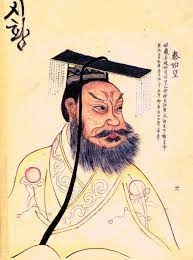 Towards the end of the Warring States Period, Shi Huangdi (aka Ying Zheng) of Qin emerged as the supreme leader with a huge army using iron weapons and chariots, who established the Qin Dynasty (221-206 BCE) and proclaimed himself as the first emperor of China. Thus, he shall be accredited with the start of the imperial era in China that lasted up to 1912 CE, following which many socio-political upheavals took place leading to the modern Communist China. Although the reign of Shi Huangdi lasted only for about 12 years, he was able to consolidate large parts of the Chinese land that constitutes the core of the Han Chinese homeland. The doctrine of Legalism had guided him which professed strict adherence to a legal code with absolute power of the Chinese emperor. It is believed that the Great Wall of China started under his reign along the northern border while within the Chinese homeland the walled fortifications of different states were demolished. During his time, Xianyang remained the imperial capital, empire was expanded, and several trunk roads built leading to great strides in infrastructure development and military campaigns. However, Shi Huangdi’s suppression of freedom made him quite unpopular, and his son and heir apparent Hu-Hai was even more ruthless, which gave rise to the intrigue and ineptitude of people and ultimate collapse of the Qin Dynasty.
Towards the end of the Warring States Period, Shi Huangdi (aka Ying Zheng) of Qin emerged as the supreme leader with a huge army using iron weapons and chariots, who established the Qin Dynasty (221-206 BCE) and proclaimed himself as the first emperor of China. Thus, he shall be accredited with the start of the imperial era in China that lasted up to 1912 CE, following which many socio-political upheavals took place leading to the modern Communist China. Although the reign of Shi Huangdi lasted only for about 12 years, he was able to consolidate large parts of the Chinese land that constitutes the core of the Han Chinese homeland. The doctrine of Legalism had guided him which professed strict adherence to a legal code with absolute power of the Chinese emperor. It is believed that the Great Wall of China started under his reign along the northern border while within the Chinese homeland the walled fortifications of different states were demolished. During his time, Xianyang remained the imperial capital, empire was expanded, and several trunk roads built leading to great strides in infrastructure development and military campaigns. However, Shi Huangdi’s suppression of freedom made him quite unpopular, and his son and heir apparent Hu-Hai was even more ruthless, which gave rise to the intrigue and ineptitude of people and ultimate collapse of the Qin Dynasty.
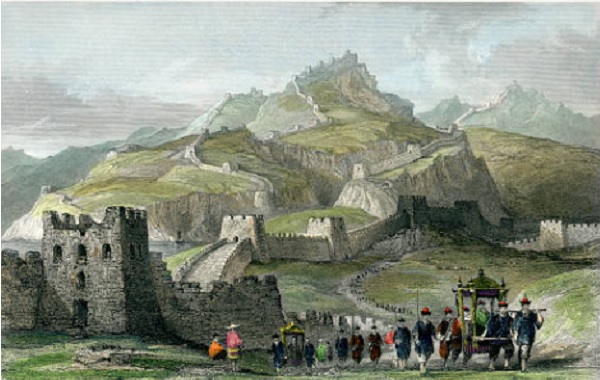
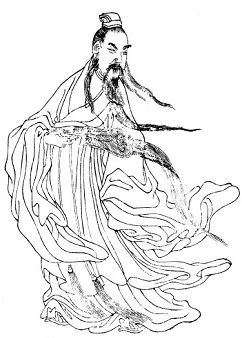 While the Qin Empire was in turmoil, the chaotic phase from 206-202 BCE was named as Chi-Han Contention. Towards the end of phase, from among the rebel generals, Liu-Bang assumed leadership; rebels sacked the Qin capital and established the Han Dynasty (206 BC-AD 220). The Han period is known as the first golden age in the ancient history of China which is known for a long stability and prosperity under a unified state and centralized imperial bureaucracy. During this period, the Chinese land was consolidated to most of the China proper and areas in the far west. Chinese culture, art and science got big boost and Confucianism was officially endorsed as state philosophy to shape the Chinese civilization. Gaozu was one emperor who is known to bring much needed stability and growth. He had embraced Confucianism making it the exclusive philosophy of the ruling dispensation. The ancient Chinese medicine system too was formally codified during the Han era. Some of the significant rulers of the Han Dynasty were Empress Lu Zhi, Emperors Hui and Wu Ti or Wu the Great. During this period, trade with the west also began and the much talked about the silk route was formally opened around 130 BCE.
While the Qin Empire was in turmoil, the chaotic phase from 206-202 BCE was named as Chi-Han Contention. Towards the end of phase, from among the rebel generals, Liu-Bang assumed leadership; rebels sacked the Qin capital and established the Han Dynasty (206 BC-AD 220). The Han period is known as the first golden age in the ancient history of China which is known for a long stability and prosperity under a unified state and centralized imperial bureaucracy. During this period, the Chinese land was consolidated to most of the China proper and areas in the far west. Chinese culture, art and science got big boost and Confucianism was officially endorsed as state philosophy to shape the Chinese civilization. Gaozu was one emperor who is known to bring much needed stability and growth. He had embraced Confucianism making it the exclusive philosophy of the ruling dispensation. The ancient Chinese medicine system too was formally codified during the Han era. Some of the significant rulers of the Han Dynasty were Empress Lu Zhi, Emperors Hui and Wu Ti or Wu the Great. During this period, trade with the west also began and the much talked about the silk route was formally opened around 130 BCE.
During the Han Dynasty, the Chinese wealth and general prosperity increased but the life of the peasants remained difficult and miserable causing resentment in masses. Consequently, enjoying popularity and massive support from the peasantry, the regent Wang Mang claimed the Mandate of Heaven for himself and took control of the state overthrowing the emperor.
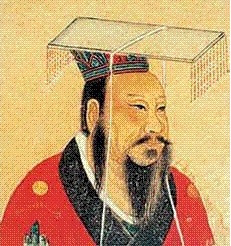 Wang Mang founded the Xin Dynasty in 9 CE with the promise of extensive land reforms and redistribution of wealth. The period of Han emperors is referred to as Western Han and those of Xin rulers as the Eastern Han period. Reportedly, during the Emperor Zhang’s rule (75-66 CE), China became so prosperous that they had extensive trade with all the major nations of the time and this trend continued for decades. According to some historians, the Romans under Marcus Aurelius considered the Chinese silk more precious than gold and paid China whatever price was asked for by them. However, the Eastern Han period also continues to be messed up with the peasantry and landed gentry issues and experienced several rebellions such as the Five Pecks of Rice Rebellion (142 CE) and the Yellow Turban Rebellion (184 CE) ushering in an era of warlords and constant turmoil.
Wang Mang founded the Xin Dynasty in 9 CE with the promise of extensive land reforms and redistribution of wealth. The period of Han emperors is referred to as Western Han and those of Xin rulers as the Eastern Han period. Reportedly, during the Emperor Zhang’s rule (75-66 CE), China became so prosperous that they had extensive trade with all the major nations of the time and this trend continued for decades. According to some historians, the Romans under Marcus Aurelius considered the Chinese silk more precious than gold and paid China whatever price was asked for by them. However, the Eastern Han period also continues to be messed up with the peasantry and landed gentry issues and experienced several rebellions such as the Five Pecks of Rice Rebellion (142 CE) and the Yellow Turban Rebellion (184 CE) ushering in an era of warlords and constant turmoil.
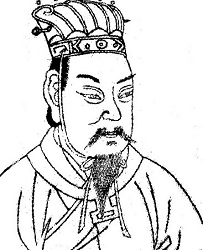 Towards the end of 2nd century, the Xin Empire too had considerably declined paving the dominance of Three Kingdoms (220-280 CE). During the Yellow Turban Rebellion, a strongman General Cao Cao had emerged who worked to reunify the Chinese land by invading South region but met with defeat there. However, his efforts of reuniting the northern parts met with considerable success and his son Wei established a dynasty in his name in 220 CE but his rivals Shu and Wu proclaimed independence, thus leading into three kingdoms in China which continued same way till 289 CE. The next four centuries in China were marred with instability, turmoil and fragmentation. In 266 CE, the Jin Dynasty overthrew the Wei Dynasty and unified the country, but this union remained only short-lived. This period experienced Jin Dynasty (266-420 CE) and sixteen kingdoms, Northern and Southern dynasties (420 -589) and Sui Dynasty (589-618 CE) with many kingdoms during the intermittent period. The Sui Dynasty is accredited with the success in reuniting China in 589 CE with the efforts of Emperor Wen (or Yang Jian) and his son Yang Guang. During the latter’s regime, the Chinese Great Wall was enlarged and improved, the Grand Canal completed, coinage system standardized and several military campaigns undertaken.
Towards the end of 2nd century, the Xin Empire too had considerably declined paving the dominance of Three Kingdoms (220-280 CE). During the Yellow Turban Rebellion, a strongman General Cao Cao had emerged who worked to reunify the Chinese land by invading South region but met with defeat there. However, his efforts of reuniting the northern parts met with considerable success and his son Wei established a dynasty in his name in 220 CE but his rivals Shu and Wu proclaimed independence, thus leading into three kingdoms in China which continued same way till 289 CE. The next four centuries in China were marred with instability, turmoil and fragmentation. In 266 CE, the Jin Dynasty overthrew the Wei Dynasty and unified the country, but this union remained only short-lived. This period experienced Jin Dynasty (266-420 CE) and sixteen kingdoms, Northern and Southern dynasties (420 -589) and Sui Dynasty (589-618 CE) with many kingdoms during the intermittent period. The Sui Dynasty is accredited with the success in reuniting China in 589 CE with the efforts of Emperor Wen (or Yang Jian) and his son Yang Guang. During the latter’s regime, the Chinese Great Wall was enlarged and improved, the Grand Canal completed, coinage system standardized and several military campaigns undertaken.
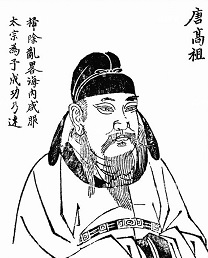 The military expeditions are said to have a series of disastrous campaigns against Goguryeo (Korean land) leading to insolvency and popular revolt against the Emperor Yang, who was ultimately eliminated by his general Yuwen Huaji. Following Yang’s death, Li-Yuan took control of the government and rechristened himself as Emperor Gao-Tzu establishing the Tang Dynasty in 618 CE. The Tang Dynasty (618-907 CE) was much stable and is often considered as the true 'golden age' of the Chinese civilization. Gao-Tzu is said to have wisely introduced the bureaucratic reforms and dispensed with extravagant military operations and building projects of the predecessor Sui dynast. Gao-Tzu was deposed and assassinated by his son Li-Shimin in 626 CE, who after eliminating own brothers and other nobilities declared himself as Emperor Taizong (626-649 CE). He, however, later established himself as remarkably efficient ruler, skilled military strategist and warrior. He was succeeded by son Gaozong (649-683 CE) whose wife Wu Zetian too ruled as Empress Wu Zetian for nearly 24 years (690-704 CE). She was known for many reforms and competent secret police force that enabled her to score over her detractors and adversaries. By the time of Emperor Xuanzong (712-756 CE), China had become probably the largest, and most populous and prosperous country in the world. The art, technology and science flourished well during the Tang Dynasty, the trade, particularly Chinese silk, with the west flourished well via Silk Route and some of the best Chinese sculpture and silverwork also belonged to this period.
The military expeditions are said to have a series of disastrous campaigns against Goguryeo (Korean land) leading to insolvency and popular revolt against the Emperor Yang, who was ultimately eliminated by his general Yuwen Huaji. Following Yang’s death, Li-Yuan took control of the government and rechristened himself as Emperor Gao-Tzu establishing the Tang Dynasty in 618 CE. The Tang Dynasty (618-907 CE) was much stable and is often considered as the true 'golden age' of the Chinese civilization. Gao-Tzu is said to have wisely introduced the bureaucratic reforms and dispensed with extravagant military operations and building projects of the predecessor Sui dynast. Gao-Tzu was deposed and assassinated by his son Li-Shimin in 626 CE, who after eliminating own brothers and other nobilities declared himself as Emperor Taizong (626-649 CE). He, however, later established himself as remarkably efficient ruler, skilled military strategist and warrior. He was succeeded by son Gaozong (649-683 CE) whose wife Wu Zetian too ruled as Empress Wu Zetian for nearly 24 years (690-704 CE). She was known for many reforms and competent secret police force that enabled her to score over her detractors and adversaries. By the time of Emperor Xuanzong (712-756 CE), China had become probably the largest, and most populous and prosperous country in the world. The art, technology and science flourished well during the Tang Dynasty, the trade, particularly Chinese silk, with the west flourished well via Silk Route and some of the best Chinese sculpture and silverwork also belonged to this period.
The period of 907 to 960 CE in the Chinese history is considered a span of the political disunity between the Tang and the Song, often cited as the Five Dynasties and Ten Kingdoms period. During this period, China remained a multi-state system with five regimes, namely, Liang, Tang, Jin, Han and Zhou, rapidly succeeding one another to control the traditional Imperial heartland in northern China. In 960 CE, the Song dynasty was founded by Emperor Taizu with capital in Kaifeng. In 979 and he was able to reunify the most part of the China mainland during the next two decades. Although the Song Dynasty was militarily not very strong but during this period China was largely stable and the institutions, customs and laws were improved, codified and integrated with the Chinese culture. During this span, the Neo-Confucianism remained more popular philosophy, influencing majority Chinese customs and laws; however, the traditional conflict between the wealthy landowners and elite class on one side and not so resourceful and poor peasantry and worker class on the other continued. During the period 960-1279 CE, parts of China proper and neighbouring territories remained under the control of warring Liao (907-1125 CE), Song (960-1279 CE), Jin (1115-1234 CE) and Western Xia (1032-1227 CE) dynasties and this era ended with the Mongol conquest of China of these dynasties one by one.
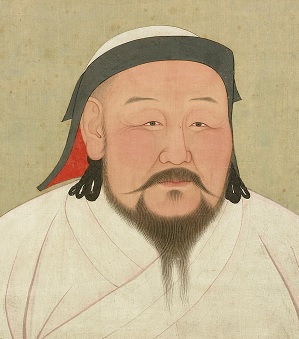 The Yuan Dynasty (1271-1368 CE) was proclaimed in China under the famous Mongol ruler Kublai Khan, who was one of the grandsons of Genghis Khan, claiming additional title of the Emperor of China in 1271 after conquest of China was nearly complete. The capital of the Yuan Dynasty was established at Khanbaliq (the modern day Beijing). The successive Mongol rulers of this dynasty largely adopted the Chinese culture but their sinification remained only to a lesser extent due to express desire to preserve racial superiority as conquerors and nomadic lifestyle. Following these attributes and exploitive tendencies, the general sentiments of the Chinese population continued against the Mongol dominance. This clubbed with incompetence governance and successive natural disasters led to popular uprisings and bloody rebellions against the Mongol rulers since 1340 CE onwards. Finally, the rebel forces under Zhu Yuanzhang captured the capital Khanbaliq, proclaimed himself Emperor of China and the left-over Mongols fled back to Mongolia.
The Yuan Dynasty (1271-1368 CE) was proclaimed in China under the famous Mongol ruler Kublai Khan, who was one of the grandsons of Genghis Khan, claiming additional title of the Emperor of China in 1271 after conquest of China was nearly complete. The capital of the Yuan Dynasty was established at Khanbaliq (the modern day Beijing). The successive Mongol rulers of this dynasty largely adopted the Chinese culture but their sinification remained only to a lesser extent due to express desire to preserve racial superiority as conquerors and nomadic lifestyle. Following these attributes and exploitive tendencies, the general sentiments of the Chinese population continued against the Mongol dominance. This clubbed with incompetence governance and successive natural disasters led to popular uprisings and bloody rebellions against the Mongol rulers since 1340 CE onwards. Finally, the rebel forces under Zhu Yuanzhang captured the capital Khanbaliq, proclaimed himself Emperor of China and the left-over Mongols fled back to Mongolia.
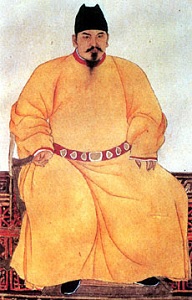 Zhu Yuanzhang established the Ming dynasty (1368-1644 CE) rechristening himself as Emperor Hongwu in 1368 CE with initially setting his capital in Nanjing and later shifting it to (modern) Beijing. He was one emperor of a peasant origin in China and, accordingly, he primarily focused on building a state relying to the maximum on agriculture. The next Yongle Emperor focused on reinforcing the Chinese supremacy in East Asia again by augmenting army and large navy and insisting other neighbouring states to pay handsome tribute. As Mongols were still bothering with intermittent attacks, considerable efforts were made to repair and built the Great Ming Wall, the remains of which are now recognized as the Great Wall of China. During the Ming Dynasty, the large urban centres such as Nanjing and (modern) Beijing grew with the growth of industries like paper, silk, cotton, porcelain goods, and so on, as also the foreign trade considerably increased. Those days, the Chinese merchants were known to reach as far as East Africa for trade sailing through the Indian Ocean.
Zhu Yuanzhang established the Ming dynasty (1368-1644 CE) rechristening himself as Emperor Hongwu in 1368 CE with initially setting his capital in Nanjing and later shifting it to (modern) Beijing. He was one emperor of a peasant origin in China and, accordingly, he primarily focused on building a state relying to the maximum on agriculture. The next Yongle Emperor focused on reinforcing the Chinese supremacy in East Asia again by augmenting army and large navy and insisting other neighbouring states to pay handsome tribute. As Mongols were still bothering with intermittent attacks, considerable efforts were made to repair and built the Great Ming Wall, the remains of which are now recognized as the Great Wall of China. During the Ming Dynasty, the large urban centres such as Nanjing and (modern) Beijing grew with the growth of industries like paper, silk, cotton, porcelain goods, and so on, as also the foreign trade considerably increased. Those days, the Chinese merchants were known to reach as far as East Africa for trade sailing through the Indian Ocean.
With the passage of time, the control of Ming dynasty over the Manchuria weakened; consequently, Manchu (Jurchen) tribes under Nurhaci claimed independence emerging as a powerful state. Li Zicheng's peasant rebellion captured Beijing in 1644 and the last Ming Emperor Chongzhen committed suicide. Though Li Zicheng retained power for a brief stint, the Manchus allied with a Ming general Wu Sangui soon seized Beijing, paving way for the Qing Dynasty (1644-1912 CE).
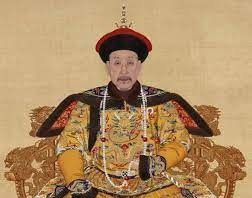 The Qing became the last imperial dynasty as also the second conquest dynasty in China after Mongols; the period was marred with the large-scale bloodshed and according to some estimates the Qing conquest cost as many as about 25 million lives. The Qing Dynasty reached its zenith during the rule of Emperor Qianlong when China probably the world’s largest economy with almost one-third population under its control. With the advent of the 19th century, the influence of European powers increased in Asia. Qing’s had to face a defeat by the British Empire in the First Opium war in 1840 ceding Hong Kong to Britain, import of opium from the colonial power and rising influence of Christianity in the region. The famous Boxer uprisings of 1900 CE in China were not only against the growing foreign influence killings many Chinese Christians and missionaries but also influenced the young Chinese officials, military officers and students with modern thoughts and revolutionary ideas against the imperial set up and feudal system. The ideas of the Chinese intellectuals like Liang Qichao and revolutionary Sun Yat-sen played decisive role in triggering the Wuchang Uprisings in October 1911 from Wuchang (today’s Wuhan) that spread fast over the Chinese land leading to the establishment of the Republic of China on 1st January 1912 ending over two millennia of the dynastic rule.
The Qing became the last imperial dynasty as also the second conquest dynasty in China after Mongols; the period was marred with the large-scale bloodshed and according to some estimates the Qing conquest cost as many as about 25 million lives. The Qing Dynasty reached its zenith during the rule of Emperor Qianlong when China probably the world’s largest economy with almost one-third population under its control. With the advent of the 19th century, the influence of European powers increased in Asia. Qing’s had to face a defeat by the British Empire in the First Opium war in 1840 ceding Hong Kong to Britain, import of opium from the colonial power and rising influence of Christianity in the region. The famous Boxer uprisings of 1900 CE in China were not only against the growing foreign influence killings many Chinese Christians and missionaries but also influenced the young Chinese officials, military officers and students with modern thoughts and revolutionary ideas against the imperial set up and feudal system. The ideas of the Chinese intellectuals like Liang Qichao and revolutionary Sun Yat-sen played decisive role in triggering the Wuchang Uprisings in October 1911 from Wuchang (today’s Wuhan) that spread fast over the Chinese land leading to the establishment of the Republic of China on 1st January 1912 ending over two millennia of the dynastic rule.
Ancient Chinese Religion: Gods and Goddesses
Like all other ancient civilizations, the ancient Chinese people too were polytheistic and worshipped multiple deities. According to an estimate, over two hundred well recognized gods and goddesses were worshipped in different parts of the ancient China. If the total count of the deities, spirits and supernatural entities is taken, this would perhaps exceed the count of one thousand. Apart from the original gods and goddesses from primordial times, every village, town or even graveyards had their own distinct deities or spirits besides the Kuei-Shen (nature spirits) which arguably resided on trees, or even in streams and gardens. Besides some mortals such as the Baxian who were believed to have attained divinity after death and were recognized and worshipped as gods. Similarly, some mythical creatures like Turtle, Qilin, Phoenix and Dragon with supernatural powers also find a mention in pantheon and mythology. According to popular Chinese belief, the gods were behind the creation of the world and human beings, and each deity had own special function, power and influence. Out of the long list, ten more important gods and goddesses are briefly described here.
1. Shangdi
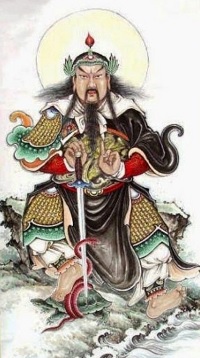 In the Chinese pantheon, Shangdi was the supreme god in-charge of the creation, law, justice and order. He is also known with the names of Shangti, Yu Huang Shang-Ti, and in some texts as Jade Emperor or Yellow Emperor. The name Shangdi as such is translated as the "Highest Deity", or even the "Primordial Deity" or "First Deity" in Classical Chinese. He was considered the great ancestor of Chinese and king of all gods, human beings and nature, who taught the people culture, architecture, agriculture, battle skills, and regulated seasons and controlled weather. He was glorified and worshipped primarily during the Shang Dynasty (1600-1046 BCE) when he was treated as a deified king who supposedly ruled during 2697-2597 BCE, a period of vague and mythical history. Shangdi was largely transcendent working through the lesser gods and was normally considered beyond the reach of common people while the Shang kings proclaimed that he could be accessed only through their royal ancestors. During the Zhou Dynasty, Shangdi was linked with the concept of the Mandate of Heaven (Tian). By the time of Han Dynasty and later era, he was conflated with the Taoist Jade Emperor.
In the Chinese pantheon, Shangdi was the supreme god in-charge of the creation, law, justice and order. He is also known with the names of Shangti, Yu Huang Shang-Ti, and in some texts as Jade Emperor or Yellow Emperor. The name Shangdi as such is translated as the "Highest Deity", or even the "Primordial Deity" or "First Deity" in Classical Chinese. He was considered the great ancestor of Chinese and king of all gods, human beings and nature, who taught the people culture, architecture, agriculture, battle skills, and regulated seasons and controlled weather. He was glorified and worshipped primarily during the Shang Dynasty (1600-1046 BCE) when he was treated as a deified king who supposedly ruled during 2697-2597 BCE, a period of vague and mythical history. Shangdi was largely transcendent working through the lesser gods and was normally considered beyond the reach of common people while the Shang kings proclaimed that he could be accessed only through their royal ancestors. During the Zhou Dynasty, Shangdi was linked with the concept of the Mandate of Heaven (Tian). By the time of Han Dynasty and later era, he was conflated with the Taoist Jade Emperor.
2. Xiwangmu (The Queen Mother of the West)
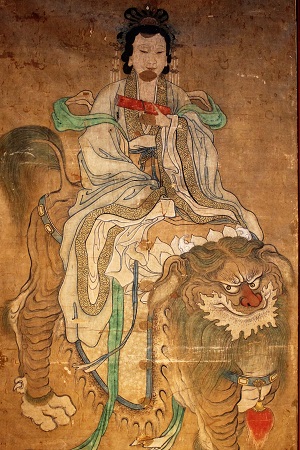 In the ancient Chinese religion and mythology, she was known as the Queen Mother or Mother goddess of west and was worshipped in China as also some other neighbouring Asian countries. The initial records on her are traced back to oracle bone inscriptions of 15th century and she is mostly associated with the Taoism. She was the goddess of immortality and queen of the immortal gods and spirits who arguably resided in the mystical land of Xihua. Her abode was a castle of gold surrounded by a moat (deep water trench) in the Kunlun Mountains, where in her imperial peach orchard the fruits produced the juice of immortality. She is shown as the wife of the god of the Spirits, Mugong but in some accounts also mentioned as the wife of Shangdi. Commensurate with her mood, Xiwangmu is depicted as a beautiful woman with sharp teeth and leopard’s tail, or as an old and hunched backed lady with tiger’s teeth and leopard’s tail. She was known to reward her faithful with eternal life but also harmed people who annoyed her. Her cult was very pronounced during the Han Dynasty with several shrines built during the period.
In the ancient Chinese religion and mythology, she was known as the Queen Mother or Mother goddess of west and was worshipped in China as also some other neighbouring Asian countries. The initial records on her are traced back to oracle bone inscriptions of 15th century and she is mostly associated with the Taoism. She was the goddess of immortality and queen of the immortal gods and spirits who arguably resided in the mystical land of Xihua. Her abode was a castle of gold surrounded by a moat (deep water trench) in the Kunlun Mountains, where in her imperial peach orchard the fruits produced the juice of immortality. She is shown as the wife of the god of the Spirits, Mugong but in some accounts also mentioned as the wife of Shangdi. Commensurate with her mood, Xiwangmu is depicted as a beautiful woman with sharp teeth and leopard’s tail, or as an old and hunched backed lady with tiger’s teeth and leopard’s tail. She was known to reward her faithful with eternal life but also harmed people who annoyed her. Her cult was very pronounced during the Han Dynasty with several shrines built during the period.
3. Yan Wang
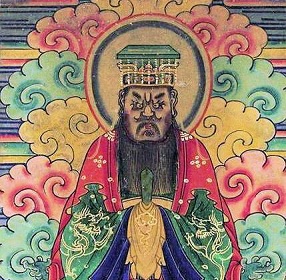 Yan Wang was the god of death and afterlife who ruled the regions of the underworld. He is also known with many other names such as Yang-Wang-Yeh, Lord Yama King or Lord Yama (under Buddhist influence). Yan Wang presided over the judgment of souls and decided their fate whether their meritorious deeds entitled them to live with gods in heaven or they should be punished for their crimes during life in the underworld or be reincarnated. As per popular Chinese belief, one could escape punishment for the sins committed on the earth but no one would escape justice in the court of Yan Wang. To illustrate the aforesaid Chinese dictum, the nemesis of a soldier having caused a great deal of sufferings on people during his life is so often quoted in ancient Chinese texts.
Yan Wang was the god of death and afterlife who ruled the regions of the underworld. He is also known with many other names such as Yang-Wang-Yeh, Lord Yama King or Lord Yama (under Buddhist influence). Yan Wang presided over the judgment of souls and decided their fate whether their meritorious deeds entitled them to live with gods in heaven or they should be punished for their crimes during life in the underworld or be reincarnated. As per popular Chinese belief, one could escape punishment for the sins committed on the earth but no one would escape justice in the court of Yan Wang. To illustrate the aforesaid Chinese dictum, the nemesis of a soldier having caused a great deal of sufferings on people during his life is so often quoted in ancient Chinese texts.
4. Guanyin
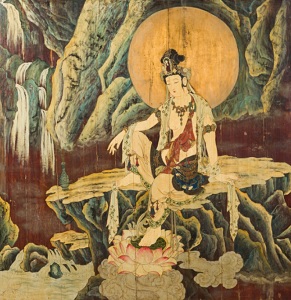 Guanyin was the Chinese goddess of mercy, compassion and the patron of sailors and fishermen. She is believed to be a carbon-copy or counter part of the female deity Tara in Buddhism who was supposedly born of the tears of Bodhisatva Avalokitesvara (meaning “"One who gazes down upon the world and hears the cries of the people"). Tara personified compassion and offered salvation to the followers from the suffering of rebirth and death. Accordingly, Guanyin was seen as the goddess of compassion, wisdom, and liberation, and was also invoked by the people for protection, guidance and deliverance from difficult situations. An interesting mythical tale is attached to Guanyin who was incarnated as the maiden Miaoshan to experience life as an ordinary human being. During the process, she had to undergo many difficult trials on earth including execution, which she returned back with only goodness. At the end of trial, the Lord of Death sent her back to the earth realm where she lived on the Fragrant Mountain, released only goodness, helped and rescued many boatmen in trouble at sea; that is how she became the patron goddess of sailors and fishermen with mass following in China as a popular deity.
Guanyin was the Chinese goddess of mercy, compassion and the patron of sailors and fishermen. She is believed to be a carbon-copy or counter part of the female deity Tara in Buddhism who was supposedly born of the tears of Bodhisatva Avalokitesvara (meaning “"One who gazes down upon the world and hears the cries of the people"). Tara personified compassion and offered salvation to the followers from the suffering of rebirth and death. Accordingly, Guanyin was seen as the goddess of compassion, wisdom, and liberation, and was also invoked by the people for protection, guidance and deliverance from difficult situations. An interesting mythical tale is attached to Guanyin who was incarnated as the maiden Miaoshan to experience life as an ordinary human being. During the process, she had to undergo many difficult trials on earth including execution, which she returned back with only goodness. At the end of trial, the Lord of Death sent her back to the earth realm where she lived on the Fragrant Mountain, released only goodness, helped and rescued many boatmen in trouble at sea; that is how she became the patron goddess of sailors and fishermen with mass following in China as a popular deity.
5. Nuwa and Fuxi
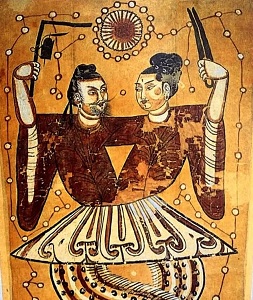 Nuwa and Fuxi are visualized as the mother and father deities of the human beings in the Chinese civilization. Nuwa and Fuxi were sister and brother duo and friends at the early creation stage. Nuwa built a palace on Mount Kun-lun for them that became a model Chinese architecture for future and two started living there. In Chinese iconography, the two are depicted as human-dragon bodies consisting of the human heads and dragon bodies or, sometimes, human bodies up to the waist with dragon legs and tails. Nuwa is believed to have created initial humans out of the yellow clay and ordinary mud but this did not satisfy them and she was still feeling lonely. Then they considered becoming wife and husband to naturally reproduce more humans themselves but were hesitant and ashamed in the beginning. So, they sought Heaven’s mandate in the form of misty vapour which was granted by gods. Thus, they changed to the wife and husband relationship and went on naturally producing the human progeny. Fuxi taught humans to make fire, writing skills, gathering food, music, culture, and so on.
Nuwa and Fuxi are visualized as the mother and father deities of the human beings in the Chinese civilization. Nuwa and Fuxi were sister and brother duo and friends at the early creation stage. Nuwa built a palace on Mount Kun-lun for them that became a model Chinese architecture for future and two started living there. In Chinese iconography, the two are depicted as human-dragon bodies consisting of the human heads and dragon bodies or, sometimes, human bodies up to the waist with dragon legs and tails. Nuwa is believed to have created initial humans out of the yellow clay and ordinary mud but this did not satisfy them and she was still feeling lonely. Then they considered becoming wife and husband to naturally reproduce more humans themselves but were hesitant and ashamed in the beginning. So, they sought Heaven’s mandate in the form of misty vapour which was granted by gods. Thus, they changed to the wife and husband relationship and went on naturally producing the human progeny. Fuxi taught humans to make fire, writing skills, gathering food, music, culture, and so on.
6. Chang'e
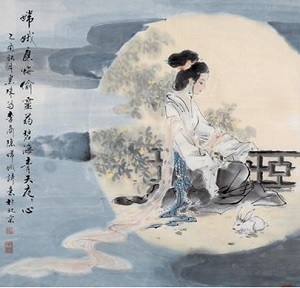 Chang'e is the goddess of the moon in the Chinese religion and mythology as also one of the popular deities of the ancient China illustrated in the poetry and literature. She was the consort of the archer god Hou Yi and the two were in great love. A famous mythical tale of the archer Yi, beautiful Chang’e, elixir (potion) of immortality and ten suns exists in the Chinese mythology with different versions. In one version, Yi and Chang’e loved each other but she betrayed him by stealing and consuming his elixir of immortality and ran across the sky to perch on the moon transforming herself into a toad to escape the notice of the betrayed husband in an endeavour to avoid his rage. Yi was stopped by a magical hare in his pursuit so that he could calm down and excuse Chang’e for her unbecoming act. By the time, Yi reached her, she had already remained in toad shape for too long to revert back to her original form again. The ancient Chinese people believed that the outline of toad was visible on the moon due to Chang’e presence and the story of the two was celebrated as the Mid-autumn Festival in ancient China and in some parts it is still continued as the Moon Festival.
Chang'e is the goddess of the moon in the Chinese religion and mythology as also one of the popular deities of the ancient China illustrated in the poetry and literature. She was the consort of the archer god Hou Yi and the two were in great love. A famous mythical tale of the archer Yi, beautiful Chang’e, elixir (potion) of immortality and ten suns exists in the Chinese mythology with different versions. In one version, Yi and Chang’e loved each other but she betrayed him by stealing and consuming his elixir of immortality and ran across the sky to perch on the moon transforming herself into a toad to escape the notice of the betrayed husband in an endeavour to avoid his rage. Yi was stopped by a magical hare in his pursuit so that he could calm down and excuse Chang’e for her unbecoming act. By the time, Yi reached her, she had already remained in toad shape for too long to revert back to her original form again. The ancient Chinese people believed that the outline of toad was visible on the moon due to Chang’e presence and the story of the two was celebrated as the Mid-autumn Festival in ancient China and in some parts it is still continued as the Moon Festival.
7. Caishen
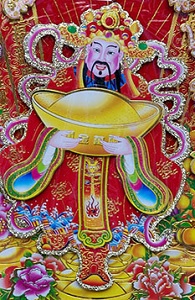 Caishen, also remembered as Ts’ai Shen, was the god of wealth and one of the most popular and worshipped deities in the ancient China and by many still even today. Statues of Caishen can be observed in the shops and business houses run by the Chinese businessmen as also in Chinese homes around the world. In popular iconography, he is depicted as a wealthy man seated in a silk robe holding riches in both hands while in some cases he is shown with two attendants carrying the bowls of gold. He was not only the deity of the material wealth but also a symbol of a happiness and prosperity with a respectable job or business. According to a popular belief, he was a very generous god to his followers but people had to prove that they were actually worthy of it by working hard and worshipping him regularly. A large number of temples and shrines were dedicated to this god in the ancient China.
Caishen, also remembered as Ts’ai Shen, was the god of wealth and one of the most popular and worshipped deities in the ancient China and by many still even today. Statues of Caishen can be observed in the shops and business houses run by the Chinese businessmen as also in Chinese homes around the world. In popular iconography, he is depicted as a wealthy man seated in a silk robe holding riches in both hands while in some cases he is shown with two attendants carrying the bowls of gold. He was not only the deity of the material wealth but also a symbol of a happiness and prosperity with a respectable job or business. According to a popular belief, he was a very generous god to his followers but people had to prove that they were actually worthy of it by working hard and worshipping him regularly. A large number of temples and shrines were dedicated to this god in the ancient China.
8. Niu Lang and Zhi Nu
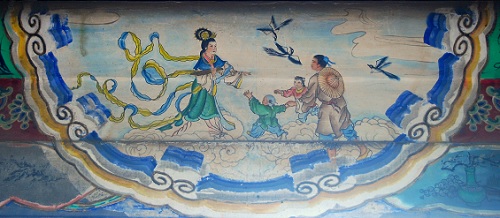
In Chinese religion, Niu Lang and Zhi Nu were the god and goddess of love. Zhi Nu was also in-charge of weaving for the gods and daughter of Shangdi. According to a popular mythical tale, once she visited earth and went for swimming in a stream leaving her clothes at the riverbanks. A cowherd Niu Lang saw her, instantly fell in love with her and intently picked up her clothes to hide it. When she came out of water, she was angry but when Niu Lang explained his feelings, she also reciprocated with love. Consequently, she stayed with Lang dropping the idea of going back to heaven. Shangdi and other gods were upset with her resolve so they sent emissaries to forcibly bring her back home. Niu Lang attempted to follow her but was stopped by Shangdi throwing a wall of stars known as Milky Way on the earth. Since that episode, the magpies fly from earth to make bridge on Milky Way once in a year so that the two lovers can cross to be together on the festival of Seventh Night of the Seventh Moon – a popular legend referenced by the Chinese writers and poets of different periods of the Chinese history. They have been immortalized with Zhi Nu rechristened as the star Vega in the constellation of Lyra and Niu Lang as Altair in Aquila.
9. Menshen
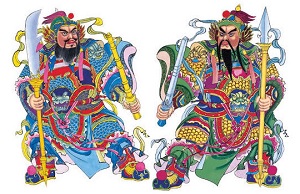 Menshen is the god of peaceful sleep as the guardian of the door supposedly securing rooms, houses and buildings from the evil spirits, ghosts and other dark forces. His origin is traced back to the Tang Dynasty when Emperor Taizong started having difficult time in having a sound sleep due to bizarre nightmares with apprehension that people actually tried to barge in his bedroom with intent to kill him. After consulting specialists, he started deputing two most trusted guards outside his room to ward off evil spirits disturbing sleep. This worked and he got their images painted on the doorway and soon other people too started painting guardians in their houses and buildings. This is how Menshen was deified and the practice of worship started among people.
Menshen is the god of peaceful sleep as the guardian of the door supposedly securing rooms, houses and buildings from the evil spirits, ghosts and other dark forces. His origin is traced back to the Tang Dynasty when Emperor Taizong started having difficult time in having a sound sleep due to bizarre nightmares with apprehension that people actually tried to barge in his bedroom with intent to kill him. After consulting specialists, he started deputing two most trusted guards outside his room to ward off evil spirits disturbing sleep. This worked and he got their images painted on the doorway and soon other people too started painting guardians in their houses and buildings. This is how Menshen was deified and the practice of worship started among people.
10. Pangu
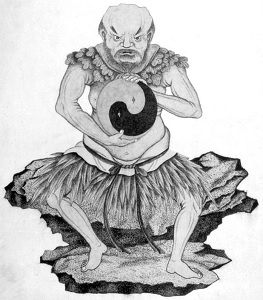 Pangu is the god of creation and is known with various names of Panku, Pan Gu or Pan Ku. In the Chinese iconography, he is depicted as a hairy dwarf with horns and body covered with fur, and sometimes bearing tusks too. Like some other civilizations, the Chinese people too believed that initially it was all darkness and chaos, out of which grew a cosmic egg for thousands of years until it broke open and Pangu emerged, who then created the world on the principle of ying and yang. For separating the earth and sky, he had to grow into a giant and various objects of nature were created out of his different body parts while fleas of his fur became various living creatures. After his demise, Nuwa appeared after many centuries and created human beings while Fuxi taught them how to live in the world.
Pangu is the god of creation and is known with various names of Panku, Pan Gu or Pan Ku. In the Chinese iconography, he is depicted as a hairy dwarf with horns and body covered with fur, and sometimes bearing tusks too. Like some other civilizations, the Chinese people too believed that initially it was all darkness and chaos, out of which grew a cosmic egg for thousands of years until it broke open and Pangu emerged, who then created the world on the principle of ying and yang. For separating the earth and sky, he had to grow into a giant and various objects of nature were created out of his different body parts while fleas of his fur became various living creatures. After his demise, Nuwa appeared after many centuries and created human beings while Fuxi taught them how to live in the world.
Aforesaid are some important Chinese revered deities while the actual list of the gods and goddesses is too long. For instance, Zao-Shen was the kitchen god responsible for the happiness and prosperity of the household subject to the conduct of people. Some other notable gods and goddesses were: Guan Gong, the god of war; Wen Chang, the god of literature patronizing scholars and writers; Fu-Shen, the god of happiness; Hou-Ji, the god of Millet and grains; Sun Wukong, the god of mischief; Sheji, the god of soil and grain; Kailushen, a divinity protecting against the ghosts and evil spirits; and Cheng Huang, the protector of walls and gates of cities. The worship of these gods and goddesses have been declared as superstition and forbidden in law by the Communist government of China but many people still privately worship many deities in the privacy of their homes.
Chinese Mythology: Legends and Myths
Like many Western civilizations, the traditional Chinese religion too was polytheistic with multiple gods and goddesses symbolizing various objects and phenomenon of the nature. To some extent it is also comparable with the Indian civilization in their belief in philosophy and spirituality albeit on a different scale and implication as represented by the ancient philosophies of Confucianism and Taoism. Besides, China has traditionally remained a land of mystery and enchantment as is vindicated by their distinct iconology of gods and goddesses, and mystical creatures like Dragon, Unicorn, Qilin, Phoenix, Turtle, and so on; many of these mystical characters had charismatic and supernatural powers. These aspects are beautifully reflected in the traditional ancient Chinese mythical tales and traditional stories. As such Chinese civilization was spread over a huge geographical area; accordingly, the mythology too reflects as a mosaic of divergent traditions and philosophies, yet the most Chinese legendary tales have an element of the conflict of common people against awesome adversities. A few more famous and representative mythical tales are briefly illustrated in the following paragraphs.
1. Pangu Created the World
Pangu (also Panku) is a primordial entity in the Chinese mythology, who is believed to have separated heaven and earth creating various geographic features such as mountains and rivers. In the Ancient Chinese philosophy, yin and yang is a concept that describes how the opposite or contrary forces (such as dark-light or negative-positive) may actually be complementary, interconnected, and interdependent to each other in the natural world, and thereby giving rise to a lot of creative results. In the beginning, the universe was in a featureless and formless primordial state with nothing but darkness and chaos which coalesced into the cosmic egg for about eighteen thousand years triggering the “yin and yang” effect. Owing to the impact of yin and yang, Pangu emerged from the egg. Pangu is usually visualized as a primordial dwarf turned giant with two horns, two tusks and a hairy body. In the beginning, with a swing of giant axe, he created the earth and sky. To make sure that the two are separated to a considerable distance, Pangu stood up between them and pushed the sky above.
Every day, the sky kept growing up by ten feet and the earth getting thicker by same measure and so was the stature of Pangu. This process is said to have continued for thousands of year; thereafter, Pangu shaped the earth by chiseling out valleys and stacking up mountains, and all such tasks were accomplished using his knowledge of yin and yang. According to some versions, he was also aided in his task by four primordial beasts, namely the Phoenix, Dragon, Qilin and Turtle. After the 18,000 years, Pangu breathed: His breath became the wind, cloud and mist; his voice became thunder; left eye, the Sun and right eye, the Moon; head, the mountains and extremes of the world; blood, the rivers; muscles, the fertile planes; facial hair, the stars and Milky Way; fur, the bushes and forests; bones, the useful minerals; bone marrow, the precious jewels; sweat, the rain; and fleas on his fur became animals. Pangu is mentioned as a central character in the Chinese Taoist myths of creation which is completely at variance with creation myths of other old world civilizations.
2. Nuwa Created People
Nuwa, or Nugua, represents the mother goddess of human beings in the Chinese mythology, who is accredited with the creation of human beings and repairing the pillars of heaven among other things. According to a popular myth, Nuwa as the creator of mankind had molded the elite class personally by hand with yellow clay but later when she got tired, she used a string to pull up the muddy clay quickly leading to the formation of the people of the lower class. The reason for creating the mankind is stated to be her sense of loneliness that became intense with time. Therefore, she initially picked up the yellow clay and molded it into the shape of human beings. After she breathed life into these manikins, they became the elite and wealthy people of society. Later, she simply dragged string across the mud in an endeavour to mass-produce people who represented the people of the lower class. This narrative suited the nobility in ancient China who thought they were more important people because the mother goddess took personal care to produce them.
In yet another version of the creation myth, there is also the concept of a great flood as in other civilizations. According to this narrative, Nuwa and Fuxi were survivors of the great flood, who were married by the command of the God. Later, Nuwa produced a child which was merely a ball of meat. This ball of meat was cut into numerous pieces, which were scattered all over the world and these pieces grew into human beings. About Nuwa’s role in repair of heaven: Once two gods namely Gonggong and Zhuanxu bitterly fought following an argument over the supremacy. Consequently, four pillars of the heaven were damaged and nine provinces (refers to erstwhile Chinese regions) were in shambles as the damaged heaven did not completely provide cover to the earth. Therefore, Nuwa smelted together five-colored stones in order to patch up the sky, cut off the legs of the great turtle to use them as four pillars among other measures to restore the worldly order.
3. Da Yu Reconstructs the Earth
The legend of Da Yu is over four thousand years old: he was the first king or demi-god of the legendary Xia Dynasty, who could even change his shape into different forms such as a bear, dragon, or human. He is credited with re-building and creation of the first dynasty of human civilization. Till the greater part of the last century, Da Yu and Xia Dynasty were considered merely part of fiction by most scholars. However, after systematic excavations suggested the occurrence of a civilization at Erlitou, Henan in 1959, such opinion has considerably changed ever since. The story of his birth too is rather vague and extraordinary that a man called Gun stole the magic soil from the heaven to dam the water of the great flood. Consequently, furious Shangdi, the supreme deity of heaven, ordered his execution. After three years, his preserved body was cut open retrieving Da Yu, who later did hard work to rebuild earth making it suitable for human habitation by taming the water.
According to one legendary account, during those times in China the rulers and leaders were decided based on their abilities and not inheritance. Through his ventures, Yu had proved his leadership and management skills during the torrential rains and flood, hence he was chosen to rule the land. Then, he established the Xia dynasty around 2,070 BCE with Yangcheng (now Dengfeng, Henan Province) as his capital. He then reorganized the country in nine states for better management, dredging of water channels to tame water and large-scale leveling of soil for cultivation to augment agricultural produce. His commitment and sustained efforts in taming the floods in China earned him the title of "Yu the Great". Subsequently, Yu also organized people to rebuild their homes destroyed in floods and develop agriculture by harnessing soil and water, and helped them to plant rice and other crops, fishery and breeding of the ducks and geese, making their lives happy and prosperous. (In Chinese mythical tales, the great flood and associated disaster actually represent the untamed Yellow River.)
4. The Moon Goddess
Chang’e (also Chang-o), the Chinese goddess of moon is part of several legendary tales of the Chinese mythology. One more popular tale revolves around Hou Yi the archer god, the elixir of life, a benevolent emperor and moon. According to this story, Chang’e was a beautiful woman and wife of Yi while Jade was one of the early gods described as Jade in the Chinese mythology. Following his noble and benevolent deeds, the gods, immortals and humans had proclaimed him as Jade Emperor and the supreme sovereign at a time. He had ten sons who were transformed into ten suns. These suns raised together high into the sky and scorched the earth threatening mankind’s very survival. So the archer Yi shot down nine of these suns sparing only one for the good of the mankind.
Consequently, the gods rewarded Yi with the “elixir of immortality” which was a potion that granted the drinker an eternal youth and life. He, however, did not consume it but gave it to his beloved wife for safe custody. While he had gone for the hunting, his apprentice Feng Meng forcibly got entry into the house and demanded the elixir from Chang’e. While she refused to give it to Feng, she consumed it herself to save it from forcibly being taken away by the latter. Consequently, she became weightless and flew upwards towards the heavens and stayed on the moon as she loved her husband and wanted to live nearby him. There are some variants of the mythical tale too suggesting her husband killed himself or she deliberately consumed elixir and flew to moon so that Yi could not reach her.
5. Legend of the White Snake
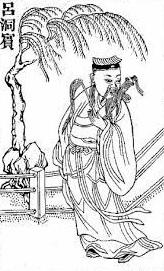 Lu Dongbin was a Chinese immortal demi-god, who one day disguised himself as a vendor in West Lake in Hangzhou and sold some tangyuan (a Chinese sweet of a ball of glutinous rice flour) to the boy Xu Xian. As after eating it, the boy did not feel hungry for days; so, he revisited vendor to inquire into the reason. To this, Lu Dongbin simply laughed and flipped the boy upside down to cause him vomit the tangyuan into the lake. A white snake spirit practicing magical arts in the lake ate it and acquired 500 years’ worth of magical powers. So, she felt grateful to Xu Xian and developed feelings for him. Few days later, the white snake saved a green snake from a man and the two treated each other like sisters. A terrapin (tortoise) spirit was envious with the white snake because he was unable to consume magical stuff instead. After many years, the white and green snakes transformed into young women with the name Bai Suzhen and Xiaoqing, respectively, during the Qingming festival. They met Xu Xian again, who lent them umbrella while it was raining; eventually, they fell in love and got married to settle down in Zhenjiang with a medicine shop. By this time, the terrapin had become more powerful, transformed into Fahai, a Buddhist monk, and plotted to break their relationship. Fahai advised Xu Xian to make her wife drink realgar wine (an alcoholic drink) during the festival; unsuspecting Bai Suzhen drank the wine and got transformed into her real self of a large white snake.
Lu Dongbin was a Chinese immortal demi-god, who one day disguised himself as a vendor in West Lake in Hangzhou and sold some tangyuan (a Chinese sweet of a ball of glutinous rice flour) to the boy Xu Xian. As after eating it, the boy did not feel hungry for days; so, he revisited vendor to inquire into the reason. To this, Lu Dongbin simply laughed and flipped the boy upside down to cause him vomit the tangyuan into the lake. A white snake spirit practicing magical arts in the lake ate it and acquired 500 years’ worth of magical powers. So, she felt grateful to Xu Xian and developed feelings for him. Few days later, the white snake saved a green snake from a man and the two treated each other like sisters. A terrapin (tortoise) spirit was envious with the white snake because he was unable to consume magical stuff instead. After many years, the white and green snakes transformed into young women with the name Bai Suzhen and Xiaoqing, respectively, during the Qingming festival. They met Xu Xian again, who lent them umbrella while it was raining; eventually, they fell in love and got married to settle down in Zhenjiang with a medicine shop. By this time, the terrapin had become more powerful, transformed into Fahai, a Buddhist monk, and plotted to break their relationship. Fahai advised Xu Xian to make her wife drink realgar wine (an alcoholic drink) during the festival; unsuspecting Bai Suzhen drank the wine and got transformed into her real self of a large white snake.
Consequently, Xu Xian died of shock that his wife was a snake. Now Bai Suzhen and Xiaoqing secretly traveled to Mount Emei to fetch the magical herb that restored Xu Xian again to life. Xu Xian continued to love Bai Suzhen after regaining life despite knowing her true identity. Fahai made yet another effort to separate them this time by abducting Xu Xian and detaining her at the Jinshan Temple. In the ensuing fight between two sisters and Fahai to rescue Xu Xian, Bai Suzhen flooded the temple and in a collateral damage even innocent people too suffered. But she being pregnant with Xu Xian’s child and with limited powers was unable to secure Xu’s release. However, later Xu Xian with his own efforts was able to escape and reunite with his wife at Hangzhou, where she gave birth to their son Xu Mengjiao. In a sheer vengeance, Fahai once again tracked them down, outsmarted Bai Suzhen and imprisoned her in Leifeng Pagoda but Xiaoqing was able to flee vowing reprisal. After another two decades, their son Xu Mengjiao earned the merit of zhuangyuan (top scholar) in the imperial examination and returned to home to reunite with parents. Around the same time, Xiaoqing, having refined and acquired more powers during these years, visited to the Jinshan Temple to confront Fahai yet again. This time she defeated Fahai, who fled and hid in the stomach of a crab; Bai Suzhen was freed from Leifeng Pagoda and reunited with Xu Xian and their son with a happy ending. The legendary white snake is still remembered as Madame White Snake and there is a Chinese saying that a crab's internal fat is orange as it matches with the colour of Fahai's kasaya.
Epilogue
In the South and East Asia, two large and great civilizations of Bharat and China, respectively, evolved independently thousands of years ago. Bharat had to constantly face the brunt of constant invasions from the Western powers, Arabs and Turks of varying cultures and religions, followed by British colonialism, since the time of Alexander in 327 BCE. However, the Chinese civilization largely remained protected and immune from the Western interventions largely owing to barrier of the inaccessible mighty Himalayas and allied mountain ranges. Consequently, what we see Bharat as India in the modern age is a fusion of different cultures and religions while still retaining many of its unique civilizational attributes. But the Chinese civilization had it own constant internal conflict and sustained wars besides iconic conquests by the Mongols and Manchus, who largely belonged to somewhat similar ethnic cultures and traditions. Therefore, the Chinese culture and religion more or less independently evolved and remained intact for long with only significant Buddhist influence and fusion in the first millennium CE. It was only after 1912 CE when the Republic of China was created and the communist influence swept over the country in later decades, the age old traditional civilizational attributes of China were destroyed by own people. Consequently, the ancient Chinese culture is more or less lost, and what we experience in China today is an autocratic, hegemonic and expansionist state with none or least regard to mankind, moral and universal values and ethics.
Continued to Next Page
Images (c) istock.com, Wikipedia and the web
02-Jan-2022
More by : Dr. Jaipal Singh